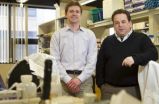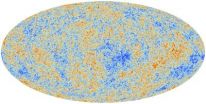BUSM researchers identify chemical compounds that halt virus replication
Could lead to the development of broad spectrum antivirals for deadly viruses
2013-03-21
(Press-News.org) (Boston) – Researchers at Boston University School of Medicine (BUSM) have identified a new chemical class of compounds that have the potential to block genetically diverse viruses from replicating. The findings, published in Chemistry & Biology, could allow for the development of broad-spectrum antiviral medications to treat a number of viruses, including the highly pathogenic Ebola and Marburg viruses.
Claire Marie Filone, PhD, postdoctoral researcher at BUSM and the United States Army Medical Research Institute of Infectious Diseases (USAMRIID), is the paper's first author and led this study under the leadership of John Connor, PhD, associate professor of microbiology at BUSM and the study's corresponding author. John Snyder, PhD, professor of chemistry at Boston University (BU) and researchers from the Center for Chemical Methodology and Library Development at BU (CMLD-BU) were collaborators on this study.
Viruses are small disease-causing agents (pathogens) that replicate inside the cells of living organisms. A group of viruses known as nonsegmented, negative sense (NNS) ribonucleic acid (RNA) viruses cause common illnesses such as rabies, mumps and measles. These pathogens also cause more serious deadly diseases, including Ebola, Hendra and Nipah. Currently, there are no approved and effective treatments against these viruses, which, according to data from the Centers for Disease Control and Prevention, are associated with mortality rates up to 90 percent following infection.
"Identifying broad-spectrum antivirals is an important step in developing successful therapies against these and other viruses," said Filone. The basic idea of a broad spectrum antiviral is similar to that of broad spectrum antibacterials in that they would allow one drug to serve as a common treatment for many different viral illnesses.
In this study, researchers identified a new chemical class of compounds that effectively blocked genetically diverse viruses from replicating by limiting RNA production by the virus in cell culture. These indoline alkaloid-type compounds inhibited a number of viruses from replicating, including Ebola.
"Because the production of viral RNA is the first step in successful replication, it appears that we have uncovered an Achilles heel to halt virus replication," said Filone. "These compounds represent probes of a central virus function and a potential drug target for the development of effective broad-spectrum antivirals for a range of human pathogens."
###
Research highlighted in this press release was funded in part by the National Institutes of Health's National Institute of Allergy and Infectious Diseases (NIAID) under grant award numbers RO1 AI1096159-01 and K22AI-064606 (PI: Connor).
ELSE PRESS RELEASES FROM THIS DATE:
2013-03-21
The American College of Medical Genetics and Genomics (ACMG) released the widely-anticipated "ACMG Recommendations for Reporting of Incidental Findings in Clinical Exome and Genome Sequencing" report at its 2013 Annual Clinical Genetics Meeting today in Phoenix. The ACMG Annual Clinical Genetics Meeting is one of the largest gatherings of medical and health professionals in genetics in the world.
As exome and genome sequencing become more commonly used in medical care, doctors will increasingly be able to learn about genetic changes that increase an individual's risk ...
2013-03-21
NEW YORK – Depressive symptoms after heart disease are associated with a markedly increased risk of death or another heart attack. However, less has been known about whether treating heart attack survivors for depressive symptoms could relieve these symptoms, be cost-effective, and ultimately, reduce medical risk? Columbia University Medical Center's Karina W. Davidson, PhD and her research team now report a patient-centered approach that answers these questions in the affirmative.
With a grant from the National Institutes of Health's National Heart, Lung, and Blood Institute ...
2013-03-21
TORONTO, March 21, 2013—Homeless people and their health care providers need to know more about traumatic brain injuries to help prevent and treat such injuries, a new study has found.
Homeless people have a disproportionately higher risk for TBI compared to the general population, yet little is known about the severity of those injuries, who exactly is suffering from them and what the long-term consequences are.
"A better understanding of TBI, its presentation and characteristics in the homeless is vital in order to enable appropriate interventions, treatments, and ...
2013-03-21
A dysfunction of a certain Calcium channel, the so called P/Q-type channel, in neurons of the cerebellum is sufficient to cause different motor diseases as well as a special type of epilepsy. This is reported by the research team of Dr. Melanie Mark and Prof. Dr. Stefan Herlitze from the Ruhr-Universität Bochum. They investigated mice that lacked the ion channel of the P/Q-type in the modulatory input neurons of the cerebellum. "We expect that our results will contribute to the development of treatments for in particular children and young adults suffering from absence ...
2013-03-21
PROVIDENCE, R.I. [Brown University] — A new study finds that two genes individually associated with rare autism-related disorders are also jointly linked to more general forms of autism. The finding suggests a new genetic pathway to investigate in general autism research.
The genes encode the proteins NHE6 and NHE9, which are responsible for biochemical exchanges in the endosomes of cells. Mutations in the NHE6 gene are a direct cause of Christianson Syndrome, while mutations in the NHE9 gene lead to a severe form of autism with epilepsy. In the new study, a statistical ...
2013-03-21
"We are very excited, we are finally seeing the concrete results of so many years of hard work". This is how the scientists of the Planck project have commented the first data resulting from the observations carried out by Planck. The mission of the ESA satellite is to observe the past of our Universe, going back in time and reaching the very first instant right after the Big Bang. The image that the Planck scientists convey today is that of a 'child' Universe, dating back to about 380,000 years after the Big Bang, when its temperature was similar to that of the most external ...
2013-03-21
The two endangered fish species, Squalius aradensis and S. torgalensis, most generally belong to the Cyprinidae, or the carp family. This is the largest fish, and vertebrate family, formed of freshwater fish with a diversity of more than 2,400 species. The family also has an important economic value as a food source. More specifically, the two species studied are members of the subfamily Leuciscinae, formed of small freshwater fish commonly known as minnows. A new genetic study of the two endangered fish was recently published in the open access journal Comparative Cytogenetics.
S. ...
2013-03-21
"Are there genetic risk factors for PCa? Yes, and BRCA2 and HOXB13 are useful for predicting high-risk disease," said Jack Cuzick (GB) president of the International Society for Cancer Prevention (ISCaP), referring to the two genes implicated in high-risk prostate disease. Cuzick gave a report on the Consensus Statement for Prostate Cancer Prevention at the closing plenary session of the 28 Annual EAU Congress held in Milan, Italy from March 15 to 19.
"The goal should be to integrate with other protein markers in order to develop risk-adapted screening algorithms," he ...
2013-03-21
This press release is available in German.
System-wide networks of proteins are indispensable for organisms. Function and evolution of these networks are among the most fascinating research questions in biology. Bioinformatician Thomas Rattei, University of Vienna, and physicist Hernan Makse, City University New York (CUNY), have reconstructed ancestral protein networks. The results are of high interest not only for evolutionary research but also for the interpretation of genome sequence data. Recently, the researchers published their paper in the renowned journal PLOS ...
2013-03-21
Planck refines our knowledge of the Universe's composition and evolution
New maps provide excellent evidence for our standard model of cosmology
Planck dates Universe at 13.82 billion years old
Anomalies suggest that Universe may be different on scales larger than those we can directly observe
Most accurate values yet for the ingredients of the Universe, with normal matter contributing just 4.9% of the mass/energy density of the Universe and dark matter making up 26.8% - nearly a fifth more than the previous estimate.
Europe's Planck satellite - a flagship mission ...
LAST 30 PRESS RELEASES:
[Press-News.org] BUSM researchers identify chemical compounds that halt virus replication
Could lead to the development of broad spectrum antivirals for deadly viruses



